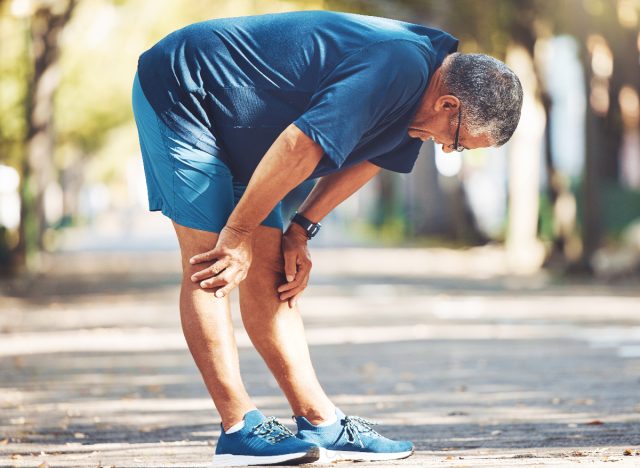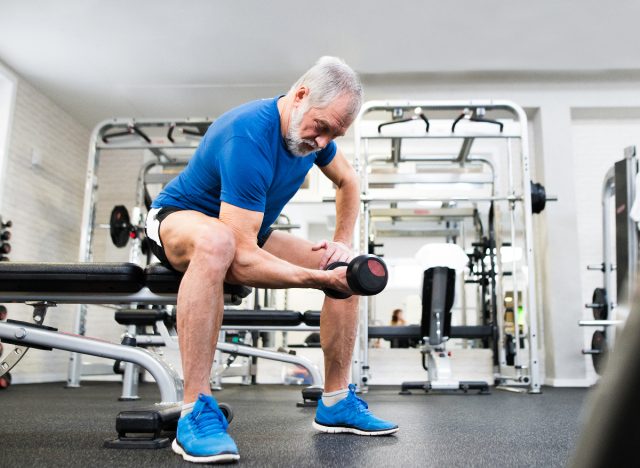Fact: You can still get into a fantastic shape in your 60s and older! But you must be careful and selective of what you do—and what you avoid—as you exercise. why? As your body ages, your recovery decreases, your mobility declines, and you may often experience nagging attacks or issues that limit your movement. Yet if you continually commit bad mistakes on top of these issues, you can further hurt your performance and even your body. We’re here to share some pretty common fitness habits that destroy your body after 60 that you should avoid at all costs. In this way, you’ll keep your body feeling great so you can make steady progress regardless of age.
Read on to learn the seven fitness habits that destroy your body after 60. And next up, don’t miss the 7 Exercise Habits That Are Destroying Your Arms After 50.

While exercising improves your muscle quantity, soft tissue work improves your muscle quality. Using foam rollers, massage balls, massage canes, etc. releases knots and adhesions that make your muscles stiff, achy, and weak. They can also promote blood flow to your muscles, which speeds up recovery.
Foam roll when warming up and cooling down from your exercise session. If you have particularly tight or tender muscles, do soft tissue therapy daily, and you will feel the difference in no time!

Another one of the top fitness habits that destroy your body after 60 has to do with your favorite machine exercises. Machines give a false sense of security. They seem safer, but they force you into rigid movements and fail to build the stability, balance and coordination that comes from non-machine movements.
Always use free weights or bodyweight exercises. Tools like dumbbells, kettlebells, suspension trainers, exercise bands, and stability balls let you perform hundreds of fantastic exercises to build a healthy and fit body.

Unless you’re severely out of shape, doing only cardio cannot create enough stimulation to increase your muscle size, strength, joint and tendon strength, or bone density. Yet as you age, these things decline, so the earlier you reverse it, the better you’ll be in your 50s, 60s, and beyond.
Do resistance training two to three times per week, and use heavier weights. On a scale from one to 10 (10 being the absolute hardest), it should feel like a seven or eight.

Unless it’s for specific rehabilitation, avoid using gloves, braces, wraps, belts, etc. while exercising. They can limit your movement and ability to sense and feel what you’re doing. For example, gloves seem to prevent calluses, but in reality, (1) you’ll get calluses anyway and (2) you won’t be able to grip your weights correctly, which throws off your technique. If you need those things, either avoid the exercises that need them or do rehab exercises with a certified professional to heal those injuries in the first place.

As you age, your muscles get tighter and joints get stiffer—this can cause aches and injuries during exercise (or even daily life). That’s why it’s so vital to dedicate time to improve your flexibility and mobility.
Make sure to stretch before and after exercise. (Do dynamic stretches beforehand and static stretches afterward.) Beyond that, try yoga or just spend a few minutes every day doing gentle stretching.

Exercise is amazing, but remember that your body improves while resting, not while training. Each week, take at least one day off from training. To stay active, you can do light stretching or take a relaxing walk. Then, every three to six weeks, reduce your training duration and intensity for an entire week to recover. Once you return to your regular routine, don’t be surprised if you become much fitter!

The last of these fitness habits that destroy your body after 60 has to do with using bad technique. Poor exercise technique compromises your performance, health, and safety. Also, exercise trains your brain and teaches you how to move during stress and fatigue. If you engrain bad movement patterns, your body will rely on them when tired, which skyrockets your chances of getting hurt.
Always use the correct technique even if you’re tired. It’s always a smart idea to get a coach to show you how to do movements correctly.
Anthony J. Yeung
Anthony J. Yeung, CSCS, is a fitness expert featured in Esquire, GQ, and Men’s Health and the founder of GroomBuilder, the destination for men who want to transform their bodies for their weddings. Join the free 5-day course to burn fat and build muscle for the big day! Read more about Anthony

